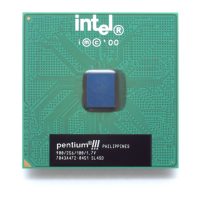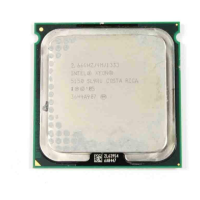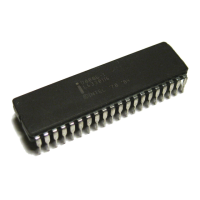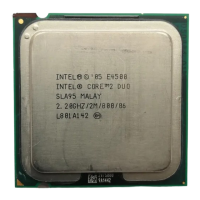72 Datasheet
Land Listing and Signal Descriptions
STPCLK# Input
STPCLK# (Stop Clock), when asserted, causes the processor to enter a low
power Stop-Grant state. The processor issues a Stop-Grant Acknowledge
transaction, and stops providing internal clock signals to all processor core units
except the FSB and APIC units. The processor continues to snoop bus
transactions and service interrupts while in Stop-Grant state. When STPCLK# is
de-asserted, the processor restarts its internal clock to all units and resumes
execution. The assertion of STPCLK# has no effect on the bus clock; STPCLK#
is an asynchronous input.
TCK Input
TCK (Test Clock) provides the clock input for the processor Test Bus (also
known as the Test Access Port).
TDI Input
TDI (Test Data In) transfers serial test data into the processor. TDI provides the
serial input needed for JTAG specification support.
TDO Output
TDO (Test Data Out) transfers serial test data out of the processor. TDO
provides the serial output needed for JTAG specification support.
TESTHI[13:0] Input
TESTHI[13:0] must be connected to the processor’s appropriate power source
(refer to VTT_OUT_LEFT and VTT_OUT_RIGHT signal description) through a
resistor for proper processor operation. See Section 2.5 for more details.
THERMDA Other Thermal Diode Anode. See Section 5.2.7.
THERMDC Other Thermal Diode Cathode. See Section 5.2.7.
THERMTRIP# Output
In the event of a catastrophic cooling failure, the processor will automatically
shut down when the silicon has reached a temperature approximately 20 °C
above the maximum T
C
. Assertion of THERMTRIP# (Thermal Trip) indicates the
processor junction temperature has reached a level beyond where permanent
silicon damage may occur. Upon assertion of THERMTRIP#, the processor will
shut off its internal clocks (thus, halting program execution) in an attempt to
reduce the processor junction temperature. To protect the processor, its core
voltage (V
CC
) must be removed following the assertion of THERMTRIP#.
Driving of the THERMTRIP# signal is enabled within 10 µs of the assertion of
PWRGOOD and is disabled on de-assertion of PWRGOOD. Once activated,
THERMTRIP# remains latched until PWRGOOD is de-asserted. While the de-
assertion of the PWRGOOD signal will de-assert THERMTRIP#, if the
processor’s junction temperature remains at or above the trip level,
THERMTRIP# will again be asserted within 10 µs of the assertion of
PWRGOOD.
TMS Input
TMS (Test Mode Select) is a JTAG specification support signal used by debug
tools.
TRDY# Input
TRDY# (Target Ready) is asserted by the target to indicate that it is ready to
receive a write or implicit writeback data transfer. TRDY# must connect the
appropriate pins/lands of all FSB agents.
TRST# Input
TRST# (Test Reset) resets the Test Access Port (TAP) logic. TRST# must be
driven low during power on Reset.
VCC Input
VCC are the power pins for the processor. The voltage supplied to these pins is
determined by the VID[5:0] pins.
VCCA Input VCCA provides isolated power for the internal processor core PLLs.
VCCIOPLL Input VCCIOPLL
provides isolated power for internal processor FSB PLLs.
VCC_SENSE Output
VCC_SENSE is an isolated low impedance connection to processor core power
(V
CC
). It can be used to sense or measure voltage near the silicon with little
noise.
VCC_MB_
REGULATION
Output
This land is provided as a voltage regulator feedback sense point for V
CC
. It is
connected internally in the processor package to the sense point land U27 as
described in the Voltage Regulator-Down (VRD) 10.1 Design Guide for Desktop
Socket 775.
Table 4-3. Signal Description (Sheet 7 of 8)
Name Type Description

